
Starfish or sea stars are star-shaped echinoderms belonging to the class Asteroidea. Common usage frequently finds these names being also applied to ophiuroids, which are correctly referred to as brittle stars or basket stars. Starfish are also known as asteroids due to being in the class Asteroidea. About 1,900 species of starfish live on the seabed in all the world's oceans, from warm, tropical zones to frigid, polar regions. They are found from the intertidal zone down to abyssal depths, at 6,000 m (20,000 ft) below the surface.
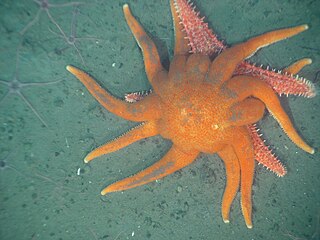
The Valvatida are an order of starfish in the class Asteroidea, which contains 695 species in 172 genera in 17 families.

The Echinasteridae are a family of starfish in the monotypic order Spinulosida. The family includes eight genera and about 133 species found on the seabed in various habitats around the world.

Astropecten polyacanthus, the sand sifting starfish or comb sea star, is a sea star of the family Astropectinidae. It is the most widespread species in the genus Astropecten, found throughout the Indo-Pacific region. The armspread is up to 20 cm (8 in). The specific epithet "polyacanthus" comes from the Latin meaning "many thorned".
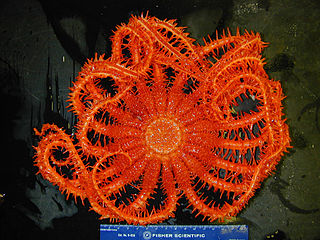
The Brisingids are deep-sea-dwelling starfish in the order Brisingida.
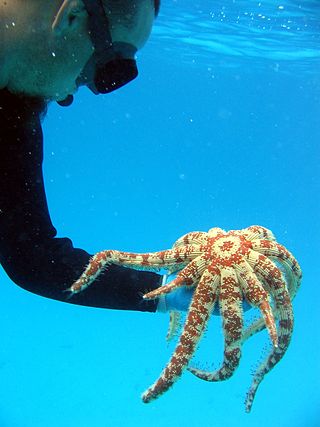
Luidia magnifica, the magnificent star, is a species of starfish in the family Luidiidae. It is found in the Pacific Ocean.

Leptasterias hexactis is a species of starfish in the family Asteriidae, commonly known as the six-rayed star. It is found in the intertidal zone of the western seaboard of the United States. It is a predator and is unusual among starfish in that it broods its eggs and young.

Solaster dawsoni, the morning sun star, is a species of starfish in the family Solasteridae. It is found on either side of the northern Pacific Ocean. It has two subspecies:
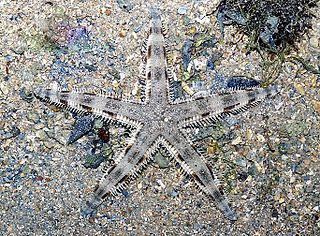
Archaster typicus is a species of starfish in the family Archasteridae. It is commonly known as the sand star or the sand sifting star but these names are also applied to starfish in the genus Astropecten. It is found in shallow waters in the Indo-Pacific region.

Evasterias troschelii is a species of starfish in the family Asteriidae. Its common names include the mottled star, false ochre sea star and Troschel's true star. It is found in Kamchatka and the north western coast of North America.
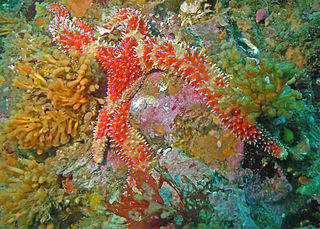
Orthasterias is a genus of sea stars in the family Asteriidae. Orthasterias koehleri, the rainbow star or red-banded sea star, is the only species in the genus. It is found in the North Pacific Ocean.

Pteraster tesselatus, the slime star or cushion star, is a species of starfish in the family Pterasteridae found in the North Pacific.

Luidia foliolata, the sand star, is a species of starfish in the family Luidiidae found in the northeastern Pacific Ocean on sandy and muddy seabeds at depths to about 600 m (2,000 ft).
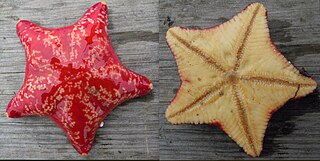
Poraniidae is a family of starfishes in the order Valvatida.

Nepanthia is a genus of starfish of the family Asterinidae. Members of the genus have four to seven rays and are found in the eastern Pacific Ocean, ranging from Burma and Indonesia to Australia.

Marthasterias is a genus of starfish in the family Asteriidae. Both species in the genus are commonly known as the spiny starfish.

Hippasteria muscipula is one of twelve species of deep-sea sea star in the genus Hippasteria, which is in the family Goniasteridae.

Freyella elegans is a species of deep-water starfish in the family Freyellidae in the order Brisingida, living at abyssal depths in the northwestern Atlantic Ocean.

Asterias rathbuni is a starfish native to the Pacific coasts of Alaska in the United States and Far East Russia. There are two subspecies.

Rathbunaster is a monospecific genus of sea stars in the family Asteriidae. The genus name was given by Walter Kenrick Fisher to honor the starfish biologist Richard Rathbun of the Smithsonian Institution. He originally ranged this genus under the family Pycnopididae, synonymous with Asteriidae.



















